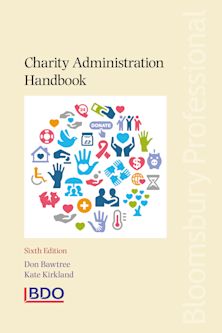Accounting Principles for Tax Purposes
Description
This title is written for tax practitioners who wish to gain a better understanding of accounting rules in the UK, how these are applied in different circumstances to a set of financial statements and what the resultant impact on the taxable profit is. The starting basis for tax computation for a business for either income tax or corporation tax is a set of accounts prepared in accordance with financial reporting standards.
HMRC employ a number of accounting specialists who consider whether the accounting treatment in a particular case is correct. While this is particularly prevalent for large companies, it is also a key issue for the smaller business. Accounting flaws will have an impact on the tax treatment and may well give HMRC grounds for discovery assessments.
Significant areas of update:
The previous (5th) edition was published in May 2014, and therefore included the changes to accounting principles as a result of the new UK financial reporting framework coming into force from 1 January 2015.
However, since then, there have been several developments and amendments to the new UK GAAP framework and the standards themselves, including:
Amendments to FRS 102 in respect of Financial Instruments classification and hedging rules issued in 2014;
Further guidance issued by ICAEW and FRC on accounting for loans at an interest rate other than a market rate;
Withdrawal of the FRSSE for small entities with effect from 1 January 2016 and the application of FRS 102 to small entities and the new FRS 105 for micro-entities;
Accompanying changes to companies legislation, particularly in respect of small entities, as a result of the implementation of the EU Accounting Directive;
Changes to small and medium-sized company qualifying criteria;
Proposed changes to FRS 102 in FRED 67 (inclusion or reference thereto may be dependent on publication date of revised standard).
In addition, as many entities are now preparing accounts under FRS 102, there is scope for the existing text to be updated where necessary for the practical experience since implementation.
Table of Contents
Part 1 – Accounting Principles and Financial Statements
2: The legal and institutional framework
3: Financial statements – What is GAAP?
4: An accounting overview
5: Back to basics: Accounting principles
6: The form and content of financial statements
7: Statements of cash flow
8: Events after the reporting period
9: Related parties
10: Accounting for tax
Part 2 – Basic Accounting Issues
11: Revenue Recognition
12: Inventories
13: Goodwill and intangible assets
14: Property, plant and equipment
15: Investment property
16: Depreciation, amortisation and impairment
17: Acquiring assets on finance
18: Financial instruments
19: Liabilities and equity, provisions and contingency
20: Employee benefits
21: Share-based payments
22: Government grants
23: Foreign currency translation
Part 3 – Advanced Accounting Issues
24: Groups
25: Corporate transactions – The theory
26: Corporate transactions – The practice
Part 4 – Special situations
27: Specialised activities
28: Limited liability partnerships
29: Smaller entities
30: Transition to new UK GAAP – this chapter will be rewritten to reflect current position
Part 5 – Conceptual Developments
31: Accounting and tax profit – Background and present position
32: Future developments
Appendices
A – Summary and commentary on the main cases
B – Accounting ratios and jargon
C – Further reading
Product details
| Published | 22 Feb 2018 |
|---|---|
| Format | Paperback |
| Edition | 6th |
| Extent | 480 |
| ISBN | 9781526503978 |
| Imprint | Bloomsbury Professional |
| Dimensions | 234 x 156 mm |
| Publisher | Bloomsbury Publishing |









